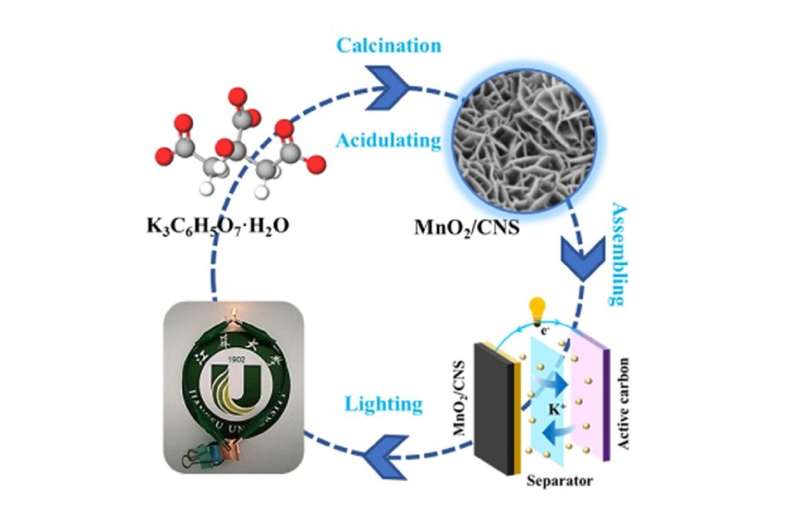Carbon nanosheets as a competent assistant to manganese dioxide show remarkable performance in supercapacitors

In the context of “carbon neutrality,” supercapacitors, as an emerging green energy storage device, have shown advantages such as fast charging and discharging, high power density and good cycling performance, which have generated a wave of research among scholars. Among them, electrode materials are one of the key factors to determine the electrochemical performance of supercapacitors. The microscopic morphology, energy storage mechanism, capacitance and safety of electrode materials will have an important impact on the performance and application of supercapacitors.
In order to enhance the energy density and electrochemical performance of supercapacitors, researchers have selected transition metal oxides with high theoretical capacitance; however, powdered transition metal oxide electrode materials all encounter problems such as small specific surface area, few active sites and structural collapse caused by large and variable particle/bulk sizes.
Wenjing Zhang from the Department of Materials Science and Engineering of Jiangsu University, and co-workers have designed and prepared a manganese dioxide/carbon nanosheet composite material to address the morphology and size distribution problems of powder electrode materials. This study was published in Frontiers of Chemical Science and Engineering on 24 February, 2022.
“After the carbonization of tripotassium citrate monohydrate and HNO3 acidification, an active CNS was produced for the uniform growth of MnO2 on its surface, eliminating MnO2 granules with nonuniform dimensions and severe agglomeration.” Zhang said.
“The activation of HNO3 produced large quantities of functional groups for the combination of CNS and MnO2 nanosheets, which provided plenty of transferring and reacting sites for ions from the electrolyte and promoted the electrochemical performance of the composite. The carbon materials offered excellent conductivity and stability under strong current; thus, the composite showed much better rate capability.”
Thanks to the constraining and regulating effect of the ultra-thin carbon nanosheets, the MnO2/CNS composite exhibits superior electrochemical properties compared to carbon nanosheet monomer and MnO2 monomer: higher specific capacitance at the same voltage, better multiplicative performance at the same current density, and lower internal resistance of the electrode material.
“The research has shown that the ultra-thin carbon nanosheets which is derived from tripotassium citrate monohydrate can be used as a substrate for the growth of manganese dioxide,” said Xuehua Yan, the co-corresponding author of this study who comes from the Department of Materials Science and Engineering of Jiangsu University.
“The electrochemical properties of manganese dioxide are effectively enhanced by adjusting its distribution. Our research broadened the idea of preparing powdered electrode materials and expanded the application of carbon materials and transition metal oxides in the field of energy storage.”
Orderly arranged bead-chain ternary nanocomposites for supercapacitors
Wenjing Zhang et al, Tripotassium citrate monohydrate derived carbon nanosheets as a competent assistant to manganese dioxide with remarkable performance in the supercapacitor, Frontiers of Chemical Science and Engineering (2021). DOI: 10.1007/s11705-021-2065-7
Provided by
Higher Education Press
Citation:
Carbon nanosheets as a competent assistant to manganese dioxide show remarkable performance in supercapacitors (2022, March 29)
retrieved 29 March 2022
from https://phys.org/news/2022-03-carbon-nanosheets-manganese-dioxide-remarkable.html
This document is subject to copyright. Apart from any fair dealing for the purpose of private study or research, no
part may be reproduced without the written permission. The content is provided for information purposes only.
For all the latest Science News Click Here
For the latest news and updates, follow us on Google News.

